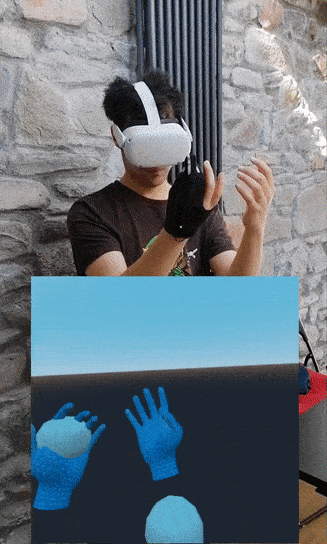PinchGlove
Physically detect pinches on the Meta Quest 2
The PinchGlove is an input device for the Oculus Quest 2. When used alongside the hand tracking of the headset, the glove detects a pinch of the index or the middle finger based on an unambiguous electric contact rather than image detection.
It is mostly useless, but I was wondering if it was possible.
Motivation
This glove is inspired by the OMG-VR gloves (also on instructable). The OMG-VR gloves were developed for Vive trackers and allow to track the hand's position and to detect pinches ("mudra" poses); all in the lightest package possible. They depend on the SteamVR lighthouses and are not compatible with the increasingly popular Oculus Quest 2 headset.
The PinchGlove attempts to achieve the same thing for the Quest. Except that the Quest has a hand tracking feature and can detect pinches using computer vision. This detection, however, can be confused with "near-contacts", occlusion, or when the hand is out of view. The glove is tracked using the headset's hand-tracking feature but detects the pinches using an electrical contact that is unambiguous.
To interface with the VR headset, the glove presents itself as a Bluetooth gamepad. Making a pinch emulates a button press.
In this repository [GITHUB]
The repository contains a description of the glove and instructions to build it, the code for the firmware, and a minimal "game" to demonstrate the functionality of the glove.
Building the glove
The "brain" of the glove is an ESP32 microcontroller with Bluetooth functionality. For this specific build, I used a TinyPICO development board that exposes all the microcontroller's pins, allows to program the chip and communicate with UART via USB, and has the circuitry to charge a LiPo battery. Because I wanted to use the board for other applications, I soldered female header pins to a protoboard that was sawed to the glove using regular thread; the board could be sawed to the glove directly, which would remove most of the bulkiness.
I used a pool glove with 3 fingers to match the aesthetics of the OMG-VR glove. Any glove would work.
The fingers are connected to the board using conductive fabric and conductive thread. A strip of adhesive conductive fabric goes from the tip of each finger to the back of the hand, next to the board. The conductive thread then goes through the conductive fabric and in holes of the board. The thumb is connected to ground, the index is connected to pin 25, and the middle finger is connected to pin 21.
I wear a second glove on top of the first one. That second glove covers the electronics that would otherwise have an adverse effect on hand tracking. It also maintains the battery in place. The tips of the second glove's fingers are cut so that the conductive fabric is exposed.
I used the following parts to build the glove:
pool gloves https://www.amazon.co.uk/gp/product/B08K8ZV7XB/
TinyPICO https://shop.pimoroni.com/products/tinypico-v2?variant=39285089534035
conductive fabric https://shop.pimoroni.com/products/woven-conductive-tape
conductive thread https://shop.pimoroni.com/products/adafruit-stainless-medium-conductive-thread-3-ply-18-meter-60-ft
prototype board https://www.amazon.co.uk/gp/product/B0775BRB6B/
Building the firmware
The firmware for the glove is written in C++ using the Arduino API. The sketch is available in the Firmware directory. It relies on the ESP32-BLE-Gamepad library to expose the glove as a Bluetooth gamepad, and the TinyPICO Arduino helper library to manage the RGB LED.
To install the firmware on the glove:
open it with the Arduino IDE
install the ESP32-BLE-Gamepad and the TinyPICO libraries using the library manager
install the specification for the TinyPICO board by following the instructions on the TinyPICO website
choose the right board and port in the IDE
plug the TinyPICO board into the computer
upload the sketch
Running the demo
The demonstration "game" shows the users hand and two spheres attached to the hands. The sphere becomes green when the glove detects a pinch between the thumb and the index, and red when it detects a pinch between the thumb and the middle finger.
The demo is written with the Godot engine and use the godot oculus quest toolkit to run on the Oculus Quest 2. Follow the setup instructions to configure both the Godot editor and your Oculus Quest to run the demo.





